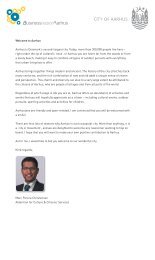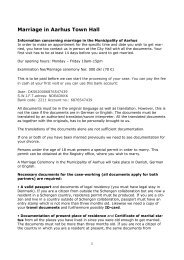Aarhus – Capital of Wind Energy - Aarhus.dk
Aarhus – Capital of Wind Energy - Aarhus.dk
Aarhus – Capital of Wind Energy - Aarhus.dk
- No tags were found...
Create successful ePaper yourself
Turn your PDF publications into a flip-book with our unique Google optimized e-Paper software.
#4The entire wind turbinesupply chain is represented inCentral Denmark. The closerelations between suppliers andmanufacturers is a tremendouscompetitive advantage.A Unique Supply Chain• <strong>Aarhus</strong> and its surrounding area is home to the biggest concentration <strong>of</strong> chain suppliers in the globalwind industry• Many have taken a leap from small family businesses to companies with global aspirations• The tradition for cooperation and major partnerships keeps the supply chain dynamic• The suppliers constitute a vast knowledge bank and is a strong asset to the Danish wind clusterOne <strong>of</strong> the strongest assets <strong>of</strong> the Danish wind turbineclusters is the great number <strong>of</strong> suppliers to the industry.No other place in the world sees the same concentrationas the Central Denmark Region. The names ‘Vestas’ and‘Siemens’ may be on the turbines, but a significant portion<strong>of</strong> their design, technology, control systems and individualcomponents is developed and manufactured by suppliersand subcontractors like KK Electronic, Niebuhr Gears andSkykon. This closely knit and geographically concentratedsupply chain is an important junction in the knowledgeinfrastructure which, from a global perspective, makes<strong>Aarhus</strong> and the surrounding area a central knowledge hubfor the industry.The large bedrock <strong>of</strong> suppliers has grown in sync withthe development <strong>of</strong> the major wind turbine manufacturerssuch as Vestas, NEG Micon and Bonus (now merged withSiemens <strong>Wind</strong> Power), It has contributed significantly tothe rapid technological development which characterisesthe wind industry. Over a few decades, the entire industryhas undergone a dramatic transformation from idealisticamateurism to big business. It now accounts for around 8.5percent <strong>of</strong> Danish export.In 1980, the average wind turbine had a capacity <strong>of</strong> 30kilowatt and a diameter <strong>of</strong> 15 metres. With current technology,it is possible to build turbines up to 5,000 kilowattwith a diameter <strong>of</strong> 115 meters. Progress has been especiallyrapid in the last five years, when global wind energy capacityhas almost quadrupled. The progress has been drivenby the major manufacturers, but their suppliers have alsoplayed an active role in the development <strong>of</strong> the industryand today, several suppliers aspire to operate globally.Small, owner-run suppliers, with perhaps just a handful<strong>of</strong> employees, are becoming pr<strong>of</strong>essionally-run businesseswith hundreds <strong>of</strong> employees.The Variety <strong>of</strong> the Supply ChainToday, a wind turbine is a tremendously complex structurewhich has more in common with contemporary aircraftsthan the windmills erected in the 1970s. That complexityis mirrored in the supply chain.A wind turbine is made up <strong>of</strong> a foundation, tower,blades and nacelle. The nacelle contains the mechanicalcomponents, cooling systems, gears, and generator, as wellas control systems and electrical components. These essentialparts are all manufactured by different, highly specialisedsuppliers. In addition to this, an “invisible” supplychain affords project planning, consulting, logistics, installation,marketing and so on. See figure 1.A closer look at the crowd <strong>of</strong> suppliers in Central Denmarkmakes the strengths <strong>of</strong> the area apparent. The 80 or sosubcontractors covers the entire chain. From DAFA inBrabrand, which supplies sealing materials, and Skykon,which has its headquarters on <strong>Aarhus</strong> Harbour and is a bigplayer in composites, towers and <strong>of</strong>f-shore foundations, toconsultancies such as Cowi, Rambøll and Niras. The companiesheavy on manpower are typically located furtherout <strong>of</strong> <strong>Aarhus</strong>, with the intensity <strong>of</strong> scientific and researchoperations gradually increasing the closer you get to the30 Mondaymorning <strong>Aarhus</strong> <strong>–</strong> <strong>Capital</strong> <strong>of</strong> <strong>Wind</strong> <strong>Energy</strong> 31




